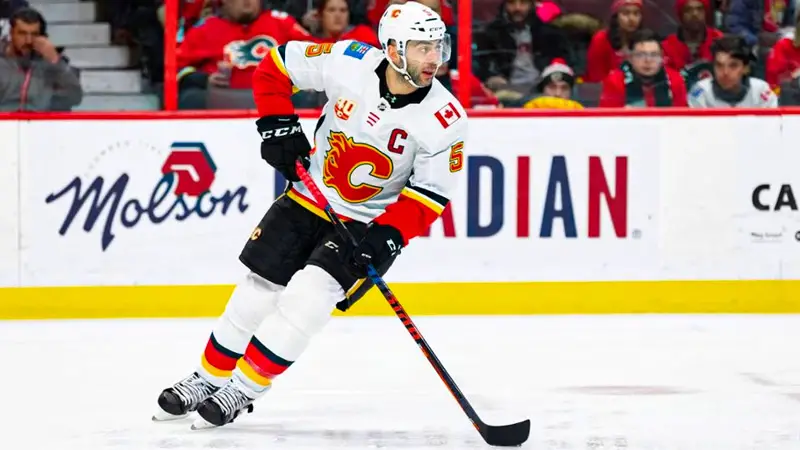In the fast-paced realm of hockey, the ability to skate swiftly is a game-changer.
Whether you’re a seasoned player or a novice, mastering the art of high-speed skating is essential for outpacing opponents, making dynamic plays, and elevating your overall performance on the ice.
This blog post delves into how to skate fast in hockey. From refining your stride technique and perfecting crossovers to understanding the significance of body positioning and edge control.
We’ll try to explore the comprehensive strategies that contribute to accelerated skating. Discover how to build strength, improve endurance, and avoid common mistakes that may hinder your speed.
Lace up your skates as we embark on a journey to unlock the secrets of unparalleled velocity in the exhilarating world of hockey. So, stay focused.
The Fundamentals of Proper Skating Technique
Proper skating technique is essential for both beginners and experienced skaters to ensure efficiency, safety, and an enjoyable skating experience.
Mastering the fundamentals of skating technique lays the foundation for improved performance and opens the door to exploring more advanced maneuvers.
Here are some key points to consider when focusing on the fundamentals of proper skating technique:
Body Position and Balance
Achieving the right body position and maintaining balance is crucial in skating. Skaters should keep their knees slightly bent, center their weight over the skates, and engage their core muscles.
This stance provides stability and control, reducing the risk of falls and allowing for smoother movements on the ice.
Proper Stride and Push
Skating efficiently requires a proper stride and push technique. Skaters should extend their legs fully with each stride, pushing from the balls of their feet to generate power.
This helps in achieving a longer glide, conserving energy, and improving overall speed.
Consistent practice of the correct stride and push contributes to muscle memory and enhances overall skating performance.
Use of Edges and Turns
Understanding how to use the edges of the skates is fundamental for executing turns and maneuvers. Skaters can create sharper turns by leaning into the edges of the skates and distributing their weight accordingly.
Learning to transition smoothly between inside and outside edges enhances agility and allows skaters to navigate curves with grace and precision.
Arm Movement and Coordination
Proper arm movement is often overlooked but plays a significant role in skating technique. Skaters should keep their arms relaxed yet purposeful, allowing for a natural swing that complements the leg movements.
Coordinated arm and leg movements enhance overall balance and contribute to a more fluid and graceful skating style.
Stopping Techniques
Learning effective stopping techniques is vital for every skater, ensuring they can control their speed and come to a complete stop when necessary.
Techniques such as the snowplow stop or the hockey stop require a combination of proper weight distribution, edge control, and balance.
Mastering these stopping techniques enhances safety on the ice and builds confidence in skaters of all levels.
Mastering the fundamentals of proper skating technique is essential for anyone looking to enjoy the sport while minimizing the risk of injuries.
How to Skate Fast in Hockey?
To skate fast in hockey, focus on key elements such as stride length, powerful pushes, and proper body positioning. Extend your strides fully, pushing off with force from the balls of your feet.
Maintain a low, forward-leaning stance to reduce wind resistance and maximize power generation.
Pump your arms in coordination with your leg movements to enhance balance and momentum. Practice quick, controlled crossovers to efficiently navigate the ice.
Strengthening your leg muscles, particularly the quadriceps and glutes, contributes to increased speed. Regularly engage in drills that emphasize speed and agility, and work on refining your stride technique.
Remember, speed in hockey is not just about raw power; it’s about mastering the mechanics of your movements for optimal efficiency on the ice.
Safety Factors to Consider While Skating Fast in Hockey

While speed is a crucial aspect of hockey, ensuring safety while skating fast is paramount.
High-speed skating demands a combination of skill, awareness, and precautionary measures to minimize the risk of injuries. Here are key safety factors to consider when skating fast in hockey:
Protective Gear
Prioritize the use of proper protective gear, including a well-fitted helmet, gloves, knee and elbow pads, and a quality mouthguard.
In the event of a fall or collision, this equipment acts as a crucial line of defense, reducing the impact and potential for injury.
Ice Condition Awareness
Stay vigilant about the condition of the ice surface. Factors like bumps, cracks, or uneven patches can pose hazards at high speeds.
Regularly scan the ice ahead, adjusting your speed and movements accordingly to navigate any obstacles safely.
Controlled Stops and Turns
Master controlled stopping and turning techniques to maintain command over your movements, especially when skating at high speeds.
Practicing proper stopping methods, like the hockey stop, ensures you can slow down or change direction swiftly and with control, reducing the likelihood of collisions.
Situational Awareness
Develop a heightened sense of situational awareness on the ice. Be mindful of the positions and movements of other players, boards, and the puck.
Anticipate potential collisions or sudden changes in play, allowing you to react promptly and avoid unnecessary risks.
Progressive Training
Gradually build up your speed through progressive training. Incremental speed increases allow your body to adapt to the demands of high-speed skating, reducing the risk of muscle strains or overexertion.
Incorporate speed drills into your training regimen, emphasizing proper technique and form.
By incorporating these safety factors into your approach to high-speed skating in hockey, you can enjoy the thrill of speed while minimizing the risk of injuries.
Pro Tips to Follow for Skating Fast in Hockey

Skating fast in hockey requires a combination of skill, technique, and strategic approaches.
Professional players emphasize certain pro tips to maximize speed on the ice, allowing for quicker transitions and more effective plays. Here are key tips to follow for skating fast in hockey:
Optimize Stride Length and Frequency
Focus on achieving a balance between stride length and frequency. While longer strides generate speed, maintaining a quick stride turnover is equally crucial.
Strive for powerful pushes with each stride, utilizing the full extension of your legs to cover more ground efficiently.
Master the Crossover Technique
Hone your crossover technique to enhance agility and speed during turns. Practice smooth and controlled crossovers, ensuring that your weight is shifted to the outside edges of your skates.
This technique minimizes friction and allows for faster acceleration when navigating corners or changing directions.
Perfect Your Hockey Stop
Mastering the hockey stop is essential for fast and controlled deceleration. Learn to distribute your weight evenly on both skates, dig your edges into the ice, and execute a quick stop.
This skill not only enhances your ability to change directions rapidly but also prevents collisions during high-speed play.
Improve Aerodynamics with Proper Posture

Maintain a forward-leaning posture to reduce wind resistance and optimize aerodynamics.
Keep your knees slightly bent, chest forward, and head up. This position minimizes drag, allowing you to cut through the air more efficiently and reach higher speeds with less effort.
Enhance Lower Body Strength
Strengthen your lower body, particularly the muscles in the thighs, hips, and calves. Building muscular power in these areas contributes to more forceful pushes and increased speed.
Incorporate strength-training exercises, such as squats and lunges, into your off-ice workouts to improve overall lower body strength.
By incorporating these pro tips into your training and gameplay, you can elevate your skating speed in hockey.
Common Mistakes to Avoid While Skating Fast in Hockey
Skating fast in hockey is a skill that requires precision and technique. However, certain common mistakes can hinder performance and even lead to accidents on the ice.
Understanding and avoiding these pitfalls is crucial for players looking to enhance their speed and agility in the game. Here are key mistakes to steer clear of while skating fast in hockey:
Overlooking Proper Technique
Neglecting fundamental skating techniques can impede your speed and overall performance. Ensure that your strides are powerful, your weight is appropriately distributed, and your edges are engaged.
Ignoring these basics can lead to inefficiencies, reduced speed, and an increased risk of injury.
Inadequate Body Positioning
Failing to maintain the right body positioning can compromise speed and control. Avoid leaning too far forward or backward, as this can affect balance and stability.
Find the optimal posture with slightly bent knees, a forward-leaning torso, and a centered weight distribution to maximize speed and maneuverability.
Ignoring Edge Control
Skating fast requires precise control over your skate edges. Neglecting edge control can result in slipping, reduced traction, and an increased likelihood of falls.
Practice and master the art of shifting weight to the inside or outside edges during turns to maintain stability and control at high speeds.
Overlooking Conditioning and Endurance
Skating fast in hockey demands significant physical exertion. Failing to prioritize conditioning and endurance can lead to fatigue, compromising your speed in the latter stages of a game.
Incorporate cardiovascular exercises and interval training into your routine to build stamina and ensure consistent speed throughout the game.
Neglecting Protective Gear
Speed increases the impact of collisions and falls, making proper protective gear essential. Neglecting to wear or properly maintain equipment like helmets, pads, and mouthguards increases the risk of injury.
Prioritize safety by ensuring that your protective gear is in good condition and worn correctly each time you hit the ice.
By avoiding these common mistakes, players can enhance their speed, agility, and safety on the hockey rink.
FAQs
How can I improve my skating speed in hockey?
To enhance your skating speed, focus on perfecting your stride technique. Ensure powerful pushes, maintain a low and forward-leaning posture, and practice quick turnovers.
Incorporate off-ice strength training to build lower body muscles for increased power and speed on the ice.
Is it important to master crossovers for speed in hockey?
Absolutely. Mastering crossovers is crucial for speed and agility. Practice smooth transitions, shift your weight to the outside edges during turns, and focus on efficient weight transfer.
This technique allows you to navigate the ice quickly, especially when changing directions or pursuing the puck.
How can I avoid fatigue while skating fast in hockey?
Prevent fatigue by prioritizing cardiovascular conditioning and endurance training. Incorporate interval workouts to build stamina.
Stay hydrated, maintain a proper diet, and ensure adequate rest. Well-conditioned players can sustain high-speed performance throughout the game.
What role does body positioning play in fast skating?
Proper body positioning is key for speed. Maintain a forward-leaning stance with slightly bent knees.
This minimizes wind resistance, allowing for efficient movement. Center your weight over the skates for balance. Correct body positioning contributes to increased aerodynamics and overall speed on the ice.
Can I skate fast without using my edges in hockey?
Using your edges is essential for fast skating. Practice edge control during turns, distributing your weight to inside or outside edges as needed.
Neglecting edge work can lead to reduced traction, instability, and difficulty maintaining speed. Mastering edge control is fundamental for high-speed performance in hockey.
Wrapping Up
In the fast-paced world of hockey, the ability to skate at high speeds is not just a skill but a strategic advantage. By incorporating the insights shared in this guide, you can take your skating prowess to new heights.
From mastering the nuances of stride technique to cultivating endurance and agility, each aspect contributes to a well-rounded, high-speed performance.
As you hit the ice, remember that the journey to achieving remarkable speed is a continuous process of refinement and practice.
Embrace these techniques, stay dedicated to your training, and watch as your ability to skate fast becomes a defining factor in your hockey success. Thank you so much.








James Felix